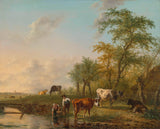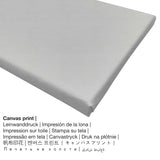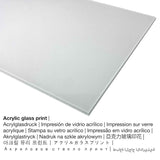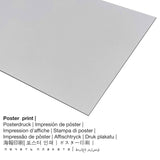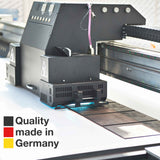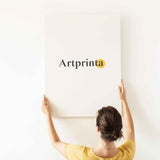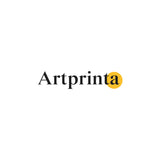Jan Kobell II, 1804 - Okirikiri ala nwere ehi - mbipụta nka mara mma
Ụtụ gụnyere. Mbupu gbakọrọ na ndenye ọpụpụ.
Na 1804 na Dutch artist Jan Kobell II created this painting. Today, the artpiece is included in the Rijksmuseum's nchịkọta. Nke nkà nke oge a ngalaba ọha A na-enye mpempe nka na nkwanye ùgwù nke Rijksmuseum.Ebe E Si Nweta nke ihe osise:. Ọzọkwa, itinye n'usoro odida obodo format na nwere akụkụ ruru nke 1.2: 1, nke pụtara na ogologo bụ 20% ogologo karịa obosara.
Họrọ ngwa ngwaahịa ị ga-atụkwasị n'ụlọ gị
Na dropdown nhọrọ ziri ezi na-esote isiokwu ị nwere ike họrọ gị onye size na ihe onwunwe. Anyị na-ahapụ gị ka ịhọrọ n'ime ụdị ndị a:
- Poster (akwa akwa akwa): The Artprinta poster print is a UV printed sheet of cotton canvas with a nice finish on the surface, which resembles the original work of art. The poster is particularly suited for framing your fine art print with the help of a custom-made frame. Please keep in mind, that depending on the size of the canvas poster print we add a white margin of something between 2-6cm around the painting, which facilitates the framing.
- Mbipụta iko acrylic (nke nwere ezigbo mkpuchi iko n'elu): The acrylic glass print, which is often labelled as a fine art print on plexiglass, will change the artwork into beautiful décor and makes a good alternative option to aluminium or canvas fine art prints. The great upside of an acrylic glass art print is that sharp contrasts plus smaller painting details will be more identifiable because of the delicate tonal gradation.
- Mbipụta kanvas: The canvas direct print is a printed canvas mounted on a wooden frame. A canvas has a special look of three-dimensionality. Further, a printed canvas generates a attractive and positive look. How can I hang a canvas on my wall? Canvas Prints have the advantage of being low in weight, meaning that it is easy to hang up the Canvas print without the support of extra wall-mounts. A canvas print is suited for all types of walls.
- Mbipụta aluminom (aluminium dibbond): An Aluminium Dibond print is a print material with an outstanding effect of depth. The Aluminium Dibond Print is your ideal introduction to art prints made on aluminum. For our Direct Aluminium Dibond option, we print your artwork on the surface of the aluminum composite.
Ederede iwu: We try what we can in order to depict our art products as clearly as possible and to showcase them visually in our shop. Please bear in mind that the pigments of the print products, as well as the printing might vary somehwat from the image on the device's screen. Depending on your screen settings and the quality of the surface, not all color pigments will be printed as exactly as the digital version depicted here. Considering that our are processed and printed by hand, there might also be slight differences in the size and exact position of the motif.
Banyere edemede a
| Bipụta ngwaahịa: | ọrụ mgbidi |
| Usoro mmeghari: | dijitalụ mmeputakwa |
| Usoro nhazi: | Mbipụta UV ozugbo (mbipụta dijitalụ) |
| Production: | Germany |
| Ụdị ngwaahịa: | mmepụta ihe na-achọ |
| Ngwaahịa were: | ime ụlọ, ihe ndozi mgbidi |
| Nhazi nka nka: | nhazi odida obodo |
| Oke akụkụ: | ogologo ruo obosara 1.2: 1 |
| Ntụgharị nkọwa akụkụ: | ogologo bụ 20% ogologo karịa obosara |
| Ụdị dị iche iche dị: | akwụkwọ mmado (akwụkwọ kwaaji), mbipụta enyo acrylic (nke nwere ezigbo mkpuchi iko), mbipụta ọla (aluminium dibond), mbipụta kwaaji |
| Mbipụta kanvas (akwa akwa na etiti ihe ndọtị): | 60x50cm - 24x20", 120x100cm - 47x39" |
| Mpempe iko acrylic (nwere ezigbo mkpuchi iko) nha: | 60x50cm - 24x20", 120x100cm - 47x39" |
| Nhọrọ nha nke akwụkwọ mmado (akwụkwọ kwaaji): | 60x50cm - 24x20", 120x100cm - 47x39" |
| Mpempe akwụkwọ Dibony (ihe alumnium) nha dị iche iche: | 60x50cm - 24x20", 120x100cm - 47x39" |
| Nhazi mbipụta nka: | enweghị etiti |
Ozi ndabere nka
| Aha nka: | "Okirikiri ala na ehi" |
| nhazi ọkwa: | sere |
| Okwu mkpokọta: | nkà nke oge a |
| Narị afọ nka: | 19th narị afọ |
| Afọ nka: | 1804 |
| Afọ nka: | gbara afọ 210 |
| Ụlọ ihe ngosi nka: | Rijksmuseum |
| Ebe ngosi nka: | Amsterdam, Netherlands |
| Ibe weebụ: | Rijksmuseum |
| Ikikere nke ihe osise: | ngalaba ọha |
| Site n'aka: | Rijksmuseum |
Nchịkọta dị mkpirikpi nke onye na-ese ihe
| Aha onye nka: | Jan Kobell II |
| A makwaara dịka: | Kobell Johann, jan kobell der altere, Kobell Johannes Baptist, Kobell Jan, Jean Kobell, Kobell Baptist, Jan II Kobell, kobell j., Kobell Jan Baptist II, Johan Kobell II, Cobell, Cobel, Feu Kobel, Jan de Kobell, Feu Kobel peintre hollandais, Johannes Kobell, Kobell d. Ae. Jan, jan kobell d. a., Kobell Johannes, Kobell Jan II, J. H. Kobell, Jan Baptist Kobell II, J. Kobell, jan kobell d.a., jan kobell d. ae., Jan Kobell II, Feu Kobell, Kobell Johannes II, Kobell Jan the younger, Kobell, Jan Kobell, Kobell Jan II, J: Kobell, Johannes Baptist Kobell |
| okike nke onye nka: | nwoke |
| Nationality: | Dutch |
| Ọrụ nke onye na-ese ihe: | onye na-ese ihe |
| Mba onye si: | mba netherland |
| Nhazi nke onye nka: | omenkà nke oge a |
| Akwụsị: | 36 afọ |
| A mụrụ: | 1778 |
| Nwụrụ n'afọ: | 1814 |
| Nwụrụ na (ebe): | Amsterdam, North Holland, Netherlands |
© nwebiisinka | www.artprinta.com (Artprinta)
Nkọwa nka nka izizi dị ka ewepụtara na ya Rijksmuseum website (© - site na Rijksmuseum - Rijksmuseum)
Landscape with cattle. In the foreground a man filling buckets and woman in a ditch. Right a barn with a thatched roof under trees. For this purpose, three cows.

